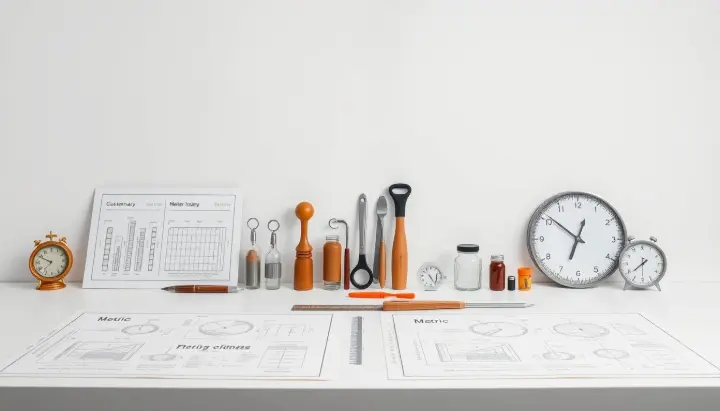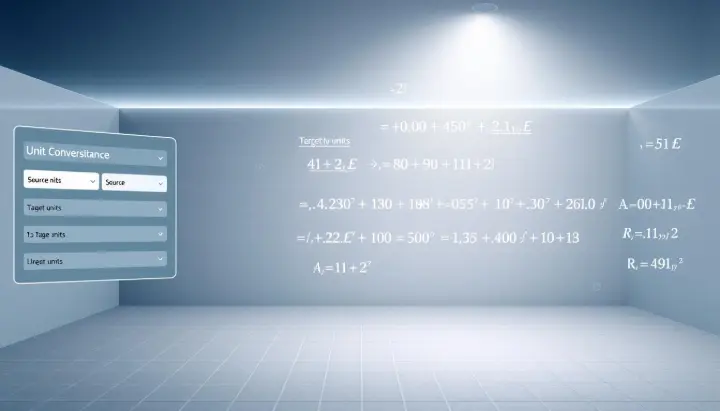Modern work demands instant access to measurement solutions. Engineers calculate steel beams in inches and centimeters. Chefs convert grams to ounces while scaling recipes. This universal challenge spans industries and borders.
A powerful unit converter bridges measurement gaps effortlessly. It handles temperature shifts from Arctic winters to desert heat. Construction teams switch between feet and meters mid-project. Scientists compare light years to atomic scales without errors. Omni Unit Converter
Five core calculators form the backbone of this system:
- Temperature adjustments for lab experiments
- Distance measurements for global logistics
- Land area comparisons for real estate
- Liquid volume translations for chemistry
- Mass calculations for international trade
The platform organizes measurements into clear groups. Users find metric options beside imperial equivalents. Specialized units appear in dedicated sections for precision work.
Key Takeaways
- Modern professionals average three measurement systems daily
- Five core calculators handle essential conversion types
- Real-time switching between metric and imperial systems
- Specialized units support scientific and industrial needs
- Clear categorization speeds up complex calculations
- Universal accessibility across devices and locations
Overview of the Omni Unit Converter Service
Global collaboration demands tools that adapt to diverse measurement standards seamlessly. Professionals juggle multiple systems daily – from Fahrenheit temperatures in U.S. labs to metric specs in international contracts. This service bridges gaps between regional practices and global requirements.

What Is This Conversion Tool?
The platform simplifies complex calculations across three primary measurement frameworks. It handles U.S. gallons alongside liters, pounds with kilograms, and miles versus kilometers. Users access conversions between customary units, metric standards, and imperial measurements through one interface.
Built-in logic recognizes that America primarily uses customary units like feet and cups. The tool also accounts for Canada's partial use of these measurements and Liberia's similar practices. Decimal-based metric conversions maintain scientific precision while preserving familiarity for domestic users.
Key Benefits for American Professionals
Manufacturers avoid costly errors when exporting goods with metric-compliant labels. Medical researchers ensure dosage accuracy when sharing data globally. Construction teams verify material quantities in both square feet and square meters effortlessly.
Real-time switching prevents miscalculations in critical fields like aerospace engineering. Logistics planners compare shipping container volumes across measurement systems instantly. The service streamlines international trade by aligning U.S. product specs with worldwide standards.
How the Omni Unit Converter Works
Precision in measurement translation fuels global projects and daily tasks. This tool transforms complex calculations into four intuitive actions, supporting professionals and casual users alike. The process adapts to diverse needs – from kitchen measurements to satellite calibration.
Simple Step-by-Step Conversion Process
- Enter the numerical value in the input field using digits or decimals
- Choose the original measurement type from categorized dropdown menus
- Select the target unit from automatically filtered options
- Review instant results displayed in the output field

Explore the Tool's Capabilities
Advanced functions enhance efficiency for repeated tasks. The swap button reverses source and target units with one click – ideal for comparing metric and imperial equivalents. Users can copy converted values directly to spreadsheets or reports.
- Real-time updates eliminate manual recalculations
- Measurement categories prevent selection errors
- Mobile-responsive design works on job sites and offices
Decimal precision meets scientific standards while maintaining user-friendly displays. The reset function clears all fields instantly for new conversions without disrupting workflow. This approach ensures accuracy across engineering blueprints, pharmaceutical doses, and international shipping manifests.
Exploring Conversion Categories
From kitchen measurements to cosmic calculations, organized systems simplify complex unit translations. The platform groups measurements into logical sections, ensuring quick access for professionals and hobbyists alike.
Temperature, Weight, and Volume Conversions
Eight temperature scales meet diverse needs. Cooks switch between Fahrenheit and Celsius for baking, while engineers use Kelvin for industrial processes. Rare scales like Rømer and Delisle appear in historical research or specialized experiments.
Weight converters handle extremes. Pharmacists measure medications in micrograms, while astronomers calculate celestial masses. Troy ounces assist jewelers, and Earth-weight comparisons aid physics education.
- Volume tools convert kitchen teaspoons to Olympic pools
- Liquid measurements include US/UK gallon differences
- Nanoscale volumes support chemical research
Length and Area Conversions Detailed
Builders switch between inches and meters mid-project. Scientists compare atomic ångströms to light-year distances. Nautical miles help sailors, while parsecs assist astronomers.
Area tools bridge measurement eras. Farmers use acres alongside square kilometers. Surveyors reference roods in legacy documents, while architects calculate floor plans in square feet.
- Subatomic to interstellar length options
- Metric/imperial area units for global projects
- Specialized units for engineering blueprints
Mastering Metric and Imperial Systems
Measurement systems shape how we quantify the world. Professionals work with multiple frameworks daily, from building skyscrapers to mixing chemicals. Understanding their origins and differences prevents costly mistakes.
Understanding Metric Prefixes and Units
The metric system uses Earth’s dimensions as its foundation. A meter equals 1/10,000,000 of the distance from equator to pole. Base units expand through decimal prefixes:
| Prefix | Symbol | Multiplier |
|---|---|---|
| Kilo | k | 1,000 |
| Milli | m | 0.001 |
| Micro | μ | 0.000001 |
Scientists use these prefixes for precise measurements. A kilometer equals 1,000 meters. A milliliter is 0.001 liters. This decimal approach simplifies calculations compared to fractions.
Key Differences Across Measurement Systems
Three main systems create global challenges. The US uses customary units like gallons and pounds. Britain employs imperial units with different values. Both differ from metric standards.
- US gallon = 3.785 liters
- UK gallon = 4.546 liters
- 1 metric ton = 2,204.62 pounds
Construction teams might confuse US and imperial tons. Bakers could mix fluid ounces between systems. Professionals verify units before starting projects.
Mastering these systems enables accurate international work. Engineers convert blueprints between meters and feet. Pharmacists calculate doses in milligrams and grains. Clear communication prevents errors across borders.
In-Depth Look at Area Conversions
Calculating surfaces requires understanding squared relationships between measurements. Unlike simple length conversions, translating acres to hectares or square miles to kilometers demands squaring the original unit values. This mathematical layer makes accurate area calculations critical for professionals working with land, buildings, or materials.
Supported Area Units and Their Applications
The square meter serves as the foundation for all conversions. One square kilometer equals a million square meters due to the squared prefix relationship. Specialized units like acres (4,047 m²) help farmers measure fields, while hectares (10,000 m²) assist city planners.
Construction teams switch between square feet and square meters daily. Architects specify materials in square centimeters for precision. Surveyors reference historical units like roods when updating property boundaries in older districts.
Real-World Use Cases in Construction and Land Management
Contractors calculate flooring needs using both square foot and square meter measurements. A 2,000 sq ft office equals 185.8 m² - precise conversion prevents material waste. International projects often require dual-unit blueprints.
Agricultural experts convert between acres and hectares for crop planning. One 50-acre farm equals 20.23 hectares. City planners use square miles for zoning maps while environmental scientists track forest loss in square kilometers.
Real estate agents translate listings between measurement systems. A 120 m² apartment becomes 1,292 sq ft for overseas buyers. Accurate conversions maintain trust during international transactions.
Advanced Features & Accuracy in Conversion
Advanced calculation tools succeed when complexity stays hidden. This system uses square meters as its universal anchor, ensuring consistency across all translations. Values first convert to this base unit before transforming into target measurements – a dual-stage process that eliminates rounding errors.
Streamlined Design for Busy Professionals
The interface prioritizes clarity with color-coded categories and logical dropdowns. Real-time results update as users adjust inputs, preventing outdated data in time-sensitive projects. Mobile optimization allows quick checks at construction sites or during international calls.
Key features maintain precision without sacrificing speed:
- Standardized reference units for cross-system reliability
- Automatic decimal adjustments for scientific accuracy
- One-click reversal of source/target measurements
Engineers verify material specs across systems while chefs scale recipes mid-prep. Researchers compare microscopic and astronomical scales confidently. This approach bridges measurement gaps through smart design rather than manual effort.
FAQ
What measurement systems does this tool support?
The converter handles metric, imperial, and US customary systems, covering units like meters, feet, fluid ounces, and square kilometers. It’s designed for seamless switching between measurement standards.
How do I convert square meters to square feet?
Enter the value in square meters, select “area” as the category, and choose square feet as the target unit. The system instantly calculates conversions using standardized ratios for accuracy.
Can I convert cubic meters to gallons?
Yes. Select “volume” conversion, input cubic meters, and choose gallons (US liquid or imperial) as the output unit. The tool automatically applies correct conversion factors for both fluid ounces and larger quantities.
Why does the US need separate conversions for some units?
While the US uses customary units like pounds and miles, some industries require metric equivalents for international compliance. The converter bridges these gaps for trade, engineering, and scientific applications.
What industries benefit most from area conversions?
Construction firms use square foot-to-meter calculations for material estimates. Land management professionals convert acres to hectares for zoning reports. Architects frequently switch between square kilometers and miles for large-scale projects.
How does temperature conversion handle decimal points?
The tool preserves precision by carrying calculations to six decimal places, then rounding results to practical decimals based on common usage (e.g., 72.5°F becomes 22.5°C).
Are historical measurement units included?
Current versions focus on modern units like kilometers and tons, but some legacy measurements (e.g., nautical miles) appear in specialized categories. Older units may be added through user requests.
